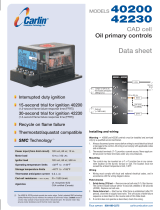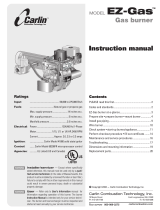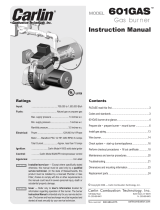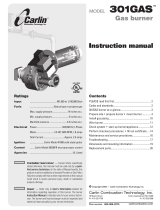Page is loading ...

Tech Support (800) 989-2275 www.carlincombustion.com
Installing and Wiring
The 70200 control must be installed and serviced only by a qualified service technician.
1. Always disconnect power source before wiring to avoid electrical shock or damage to the control. All wiring must
comply with applicable codes and ordinances.
2. Thermostat terminals (T-T)
provide a current source.
Never apply external power
to these terminals under any
circumstances.
3. Alarm terminals provide a
24 VAC/VDC-rated dry
contact, suitable for use with
security/fire alarm systems.
Mounting
• The control may be mounted
on a 4" x 4" junction box in
any convenient location on
the burner, furnace or wall.
The location must not exceed
the ambient temperature limit,
140°F.
Wiring
• Wiring must comply
with local and national
electrical codes, and with
the wiring diagram.
Model 70200
Universal Oil Primary Control
Data Sheet
• Replaces Carlin, Beckett, Honeywell
and ICM Primary Controls
• On-Board LCD Screen
no special tool needed
• Valve delay on
(0, 3, 10, 15, 30, 60, 120, no valve)
• Trial for ignition time (15, 30, 45)
• Motor Delay Off
(0, 10, 15, 30, 120, 300, 900)
• Interrupted duty or Smart Ignition
operation
• Early Spark Termination Timing
(0, -5, -10)
• Number of recycles (0, 3, Unlimited)
• Serviceman reset protection (3)
• TT Option (jumpered or open)
• Blocked vent protection
• Dry set of Alarm contacts
• Built-in Pump Prime
• Provides cad cell reading in OHMS
• Fault history records last 50 fault
cycles, easy to understand icons
displayed on screen for common
failures, Valve, Motor, Ignitor
Power input (red/white wire) 120 VAC, 60 HZ, 9 VA
Limited circuit input (black wire) 120 VAC, 60 HZ
Motor load (orange wire) 10 FLA / 60 LRA (reduce by valve load)
Ignitor load (blue wire) 120 VAC, 60 HZ, 500 VA
Vent input 120 VAC, 60 HZ
Valve load 2 amps
Vent load 0.1 amp
Line heater 1 amp
Alarm contacts (dry contacts) 24V, AC/DC, 2A
Operating temperature limits +32°F to +140°F
Storage temperature limits -40°F to +185°F
Thermostat anticipator current 0.1 A, AC
Agencies UL recognized (US & Canada)
Programmable, Microproces-
sor Based, Universal Re-
placement for CAD Cell Oil
Burner Primary Controls

© Copyright 2012 - Carlin Combustion Technology, Inc. MN70200 012315
Programming and Setup
Denitions:
Valve Delay On: Time period motor and ignitor are on prior to Trial for Ignition.
Trial for Ignition (T.F.I.): Burner ame-establishing period. Note: Do not use 45 TFI for burners larger than 3GPH.
Motor Delay Off: Time period the motor is on after the Call for Heat is satised to allow for evacuation of combustion gases.
Early Spark Termination: Amount of time prior to the end of TFI when the ignitor is turned off (burner ame must be self supporting).
Flame Stabilize: The time period after TFI that the ignitor remains on (in interrupted ignition mode only).
Ignition Type: Interrupted duty: spark is turned off after a set period; Smart Ignition: If ame is lost at any time after the Trial-for-Ignition period, the
control will recycle (60 - 65 seconds). Following this recycle, the control will operate in Intermittent Duty mode (ignition on throughout the call
for heat) for ten heat cycles. Following these ten cycles, the control will revert back to Interrupted Duty and will remain in Interrupted Duty until
another recycle event occurs.
Smart Ignition: Switches to Interrupted Duty to dramatically extend the life of the ignitor or transformer.
TT Jumpered: Allows TT to be “jumpered” by software program.
Vent Input: Used to verify vent input. When selected, if the vent input is not detected for 5 seconds during motor on time, the control will lockout.
Allowed Recycles: Number of Recycles allowed during a single Call for Heat prior to lockout.
Baseline Reset: Select Yes then push Enter- Resets baseline statistics used by fault history.
Factory Defaults: To reset to factory defaults- select Yes, then push Enter.
Inhibited Features: indicates that feature is inhibited due to other control settings:
• If Motor Delay Off is set to anything other than “0”, then Valve Delay On “0” is inhibited.
• Valve Delay On can only be set to “0” if Motor Delay off is also set to “0”.
• If Early Spark Termination is active (-10, -5), then Flame stabilization and Intermittent ignition type are inhibited.
• If Flame Stabilization is active (+5, +10, +15, +30, +45), then Early Spark Termination is inhibited.
• If set for intermittent ignition, early spark termination and Flame Stabilize are inhibited.
• Valve Off: Valve output functions but will not be reported as a fault.
Do not start the burner if the combustion chamber contains oil or oil vapor.
Per UL requirements, the control will not turn on if the cad cell senses ame (light) during the self-test. If the cad cell sees ame,
the control will remain in self-test mode until the cad cell no longer senses ame.
To Enter Programming Mode:
Simultaneously press and hold the the ▲ + ► buttons for three seconds. The display will show To Exit Setup, ESC for 3 seconds.
To View Current Settings:
Once in programming mode (above), use the ► button to scroll through all options (see table above). The control will display the current setting
for each option.
To Change Settings:
Once in programming mode (above), press the ► button to select the desired option, then use the ▲ or ▼ buttons to scroll through available
settings (see table above). Select the desired setting and press the ENTR button.
To Exit Set-Up Menu:
Press ESC button for three seconds to exit the Set-Up menu at any time. Any changes will be saved.
Example: To change the Motor Delay Off from 30 seconds to 15 seconds: Press and hold the ▲ + ► buttons for three seconds.
The screen will display To Exit Setup, ESC for 3 seconds. Now press the ► button three times to get to the Motor Delay
Off option. The screen will display Motor Delay Off and the current setting. Now press the ▼ button to select the 15 second
setting. Then press ENTR. The display will read Entered . Press and hold the ESC button to exit the set-up menu.
To Restore Control Default Settings:
Enter the programming mode (Press and hold the ▲ + ► buttons for three seconds). Using the ► button, scroll to the Factory Default
option. Press the ▲ button to select Yes . Then press ENTR. The display will read Entered . Press and hold the ESC button to exit the set-
up menu.
Shaded box = default settings
Valve
Delay On
T.F.I. Motor Delay
Off
Early Spark
Termination
Flame
Stabilize
Ignition
Type
TT
Jumpered
Vent
Input
Allowed
Recycles
Baseline
Reset
Factory
Defaults
No Valve
120 900
60 300 +45
30 120 +30
15 30 +15
10 45 15 -10 +10 No Limit
3 30 10 -5 +5 Smart
Intermittent
Yes Used 3 Yes Yes
0 15 0 Off Off Interrupted No Not Used None No No

© Copyright 2012 - Carlin Combustion Technology, Inc. MN70200 012315
Power ON Open all manual oil line valves. Close the line switch.
Call for Heat Set thermostat (and limit) to call for heat. Thermostat circuit must be closed and power must be coming to black wire from
limit circuit.
Burner On The ignitor starts, followed 3 seconds later by the motor. (This delay compensates for sluggish start-up of some AC
transformers).
Valve Delay On The oil valve opens after the Valve Delay On period (pre-purge). Note: For oil valve delay on operation, wire oil valve to
the violet terminal. If not using an oil valve, cap the violet terminal to automatically disable pre-purge and post-purge).
TFI The CAD cell must sense ame within the TFI time limit. Insufcient ame puts control into lockout.
NOTE: Push View Ohms button anytime during run to view Ohms reading.
Run The burner continues ring during call for heat if the CAD cell senses ame.
Lockout If CAD cell does not sense ame within the TFI time limit after burner starts, lockout occurs.
To Reset Push in and hold the red Reset button for 1 second, then release.
Latch-up If the control locks out 3 times during a single call for heat, latch-up occurs and will be displayed on screen. The procedure
below must be used to reset the control after latch-up.
Only a qualied service technician should attempt to reset the control after latch-up.
Reset after The problem that caused the repeated burner lockouts must be corrected before returning the burner to normal operation.
Latch-up Push in and hold the red Reset button for 30 seconds. After 30 seconds, the word Latch-up will disappear from the screen
and the control will now be in Standby ready to resume normal operation.
NOTE: The 70200 control will not reset from lockout or latch-up if power is interrupted.
Flame Failure If the CAD cell loses ame signal during operation (after the TFI), the oil valve closes within 2 seconds. The motor remains on
for the Motor Delay Off period, then shuts off. (If no oil valve is wired to the control, the burner shuts down within 2 seconds.)
Recycle: Control waits for 65 seconds then returns to standby.
Delay Motor Off Set thermostat (or aquastat) to stop call for heat. The oil valve (if installed) will turn off within 2 seconds. The motor remains on
for the Motor Delay Off period (post-purge), then turns off. (If no oil valve is wired to the control, the burner shuts off within
2 seconds after end of call for heat. There is no post-purge).
Stand-by The control remains in stand-by mode until limit circuit sends power to the black wire and thermostat circuit closes (call for heat).
Operating and Fault History
The 70200 stores all operating history and information from the last 50 cycles in which a fault condition occurred.
To Enter the History Menu:
Simultaneously press and hold the ▼ + ► buttons for 2 seconds. The display will read To Exit History ESC for 3 Sec .
To View Operating History:
Once in the History mode (above), press the ► button, the display will read: Fault Cycles then press the ▼ button to scroll through the
operating history which includes: Total Cycles , Total Run Time , Total Burn Time , Total On Time , Baseline Time ,
Max Line Volts , Min Line Volts , Recycles , Run Time , Burn Time , Max Flame Delay , and CFH Cycles .
To View Fault History:
1. Once in the History mode, press the ► button, the display will read: Fault Cycles followed by the number of cycles (max 50) that have
experienced a fault condition since the last Baseline Reset.
2. Press the ► button again to scroll through the history of fault conditions. The control will display 1: Fault Message . The number 1
indicates that this was the most recent fault condition experienced.
3. Next, press the ▼ button to determine the cause of the fault. The display will show the fault number (in this case, fault No. 1) followed by an
asterisk (*) and the problem experienced (ex. 1*CAD Ohms 5040 Ohm ). This would indicate that the fault condition was caused by a high
CAD cell reading
Pump Prime The 70200 control is equipped with a 120 second pump prime feature. To enter Pump Prime, Limit Input must
(Bleeding) be present.
If a ame is present, the control will not enter Pump Prime mode.
To bleed the oil line, with Limit icon on, push and hold red Reset button for 5 seconds. The display will read Pump Prime.
The motor, valve and ignitor remain on for up to 2 minutes while in Pump Prime mode. To end Pump Prime mode, press the red
Reset button. Note: If ame is sensed, Pump Prime mode ends in 5 sec.
Pump prime cannot be entered from Lockout or Latch-up.

Service & Troubleshooting
Burner (control) will not come on
No power to control
• Check line voltage to the control (at least 102
vac
).
• Check all electrical connections.
Control is in lockout
• Press the reset button for 1 second.
CAD cell seeing light
• Light is leaking into the burner housing, or
• CAD cell is defective, or
• There is a problem with the CAD cell wiring or holder.
• If appliance was recently shut down, CAD cell may see residual hot
spots in chamber.
To troubleshoot:
• Press the ▲ button to display cad cell Ohms. Dark resistance should
be over 50K ohms, and room light resistance (control ipped open)
should be less than 10K ohms. Replace cell if necessary, or reinstall
and close the burner housing.
• Press the ▲ button to display cad cell Ohms. Check for stray light by
measuring the CAD cell resistance looking into the inactive combus-
tion chamber. It should read greater than 50K ohms.
Other no start problems
If the CAD cell is OK,
• Valve lead voltage on too early. Correct bad connection.
• Line voltage <90 VAC. Check line voltage.
• Motor relay welded. If valve has no voltage, and line voltage OK, the
issue is a welded motor relay. Replace the control.
• Motor current less than 0.2 Amps.
Repeated ame failures
Check for:
• CAD cell is defective. Replace.
• Air leaking into oil line causing ame out – check oil line con-
nections and lter gasket.
• Defective nozzle causing ame to be erratic – change nozzle.
• Excessive airow or draft causing ame to leave burner head-
check for proper air band setting and draft.
• Excessive back pressure causing ame to be erratic – check
appliance and ue for sooting/plugging.
Control locks out at end of TFI
Check for:
• No oil to burner – check oil supply, lters, lines.
• Shorted electrodes – inspect for cracked porcelain and replace
as needed.
• Poor spark – check electrode spacing and condition per burner
manual. Replace or realign if necessary.
• Nozzle clogged – replace nozzle.
• Airow too high – check air band setting.
• Ignitor module defective – replace if no spark.
• CAD cell defective.
• Oil valve (if used) stuck in closed position.
• Check wiring connections.
Fault History (continued)
4. Continue to press the ▼ button to view other possible causes of the fault. Fault conditions are indicated by an asterisk. Normal readings non-
fault readings) will be indicated with a colon in place of the asterisk.
5. To view faults experienced in earlier run cycles, press the ► button. The control will display 2:Fault Message followed by
3:Fault Message , etc. Press the ▼ button (see step 3 above) to determine the cause of the fault selected.
To Exit History Menu:
Press ESC button for three seconds to exit the History menu at any time.
Status Icons
Status Icons will appear at the top of the 70200 display to indicate the control’s current operating condition.
POWER Indicates that the control is powered
TT Displayed when the TT terminals are physically jumpered, jumpered in the set-up menu, or when thermostat is calling for heat.
LIMIT Indicates that the burner limit circuit is powered.
IGNITOR Indicates that the ignitor is energized (ashes if ignitor not detected)
MOTOR Indicates that the motor is energized (ashes if motor not detected)
VALVE Indicates that the valve is energized (on entry to pump prime will ash if not detected)
VENT Indicates vent input is active (when vent input is selected)
FAULT Flashes in unison with other status icons indicating a problem exists in that area
FROZEN PIPES/WATER DAMAGE
This is not a freeze protection device. Suitable freeze protection monitoring or other precautions are recommended to protect against
ruptured pipes/water damage caused by fuel outage, safety related fault conditions or equipment failure.
© Copyright 2012 - Carlin Combustion Technology, Inc. MN70200 012315
/







